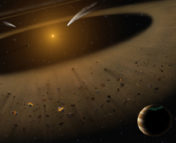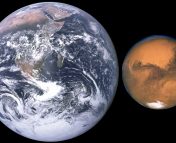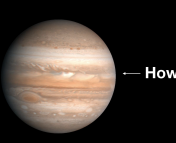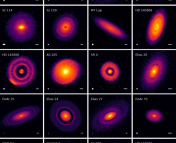Title: Terrestrial planet formation from lost inner solar system material
Authors: Christoph Burkhardt, Fridolin Spitzer, Alessandro Morbidelli, Gerrit Budde, Jan H Render, Thomas S Kruijer, Thorsten Kleine
First Author’s Institution: Institut für Planetologie, University of Münster, Münster, Germany.
Status: Science [Accepted — Open Access]
When you wake up in the morning, what’s the first thing you think of? It probably isn’t “how did the Earth form,” but it might be! And if it is, that is one good, yet tricky question to ask. Even though we’ve been living on the Earth for thousands of years, we still don’t know how exactly the Earth, and similar rocky planets, formed.
For a while, the leading theory in planet formation predicted that these planets were formed from within the inner part of the solar system. Dust within this region of the solar system accumulated to form planetary embryos that were approximately the size of the moon. Then, over time, these embryos collided to form the planets we know so well (see the top part of Fig. 1).
However, there is a new theory for planet formation involving the outer solar system. Rather than the planet embryos colliding with each other, little dust pebbles (approximately the size of a millimeter) from the outskirts of the Solar System moved inwards, accumulating on the embryos to form our planets (see the bottom part of Fig. 1).
Theoretically, both of these scenarios are equally plausible. So how can we determine which theory is correct for the Earth? The key lies in studying nucleosynthetic isotope anomalies. “Nucleosynthetic isotope anomalies” is a fancy way of describing the fact that dust within the solar system is heterogeneous, and so there will be different isotope abundances depending on where in the solar system you are. This leads to different compositions for planets formed from inner vs. outer solar system material. Thus, to determine which formation model is right, we can just compare the composition of rocky planets with inner and outer solar system objects to see which they more closely resemble.
Examining the abundances of Earth’s isotopes, and comparing them with inner and outer solar system objects, has been done in the past, but the studies have been rather limited. They have mainly focused on comparing the abundance of a single element, rather than doing a multi-element analysis. Today’s authors do a major multi-element analysis that, spoiler alert, leads them to support a model in which planets largely form from inner solar system material.
Data, data, data!
There are four rocky planets in the solar system: Earth, Mars, Mercury, and Venus. Today’s authors focus on two of these four: Earth and Mars. They compare the abundances of nine different isotopes on the Earth and on Mars (they use 17 different martian meteorites for their analysis) with those of objects known to originate in the inner and outer solar system. But what inner and outer solar system objects can they compare them to? Carbonaceous and non-carbonaceous meteorites! Carbonaceous meteorites are a class of meteorites which are thought to form in the outer solar system while non-carbonaceous meteorites are thought to form in the inner solar system. By comparing the composition of carbonaceous meteorites and non-carbonaceous meteorites with the composition of the Earth and Mars, we should get a sense of where the materials for these rocky planets came from.
Let’s get analyzing!
To determine whether the samples from Mars and the Earth are more like non-carbonaceous meteorites (NC) or carbonaceous meteorites (CC), the authors compare the deviations from the standard terrestrial values of the abundances of one isotope with that of another isotope for all four classes of objects (Earth, Mars, NC, & CC).
As seen in Fig. 2, the samples from Earth and Mars both closely follow the linear trend of the non-carbonaceous meteorites (the meteorites formed in the inner solar system) for most of the elements studied. If you look really closely though, you will see that Earth is always lurking on the outskirts of the non-carbonaceous meteorites line, and sometimes even so much as jumps a bit away from the red line in the direction opposite of that of the carbonaceous meteorites (e.g. the green circle seems to almost be repelled by the purple circles/squares). What does this mean for our Earth? It’s composition has likely been enriched in a way that cannot be described by our current sample of non-carbonaceous meteorites (the red circles/squares). If you happen to be interested in the nitty gritty details of it, the thinking is that some of the elements which later formed the Earth were enriched by the slow neutron capture process (s-process), leading to lower ε94Mo and ε96Zr levels. The fact that this is not seen as strongly in the samples from Mars is likely due to Mars’ location farther from the Sun.
However, not all isotope comparisons lend such strong evidence for a solely inner solar system model. As seen below in Fig. 3, for the comparison of 95Mo and 94Mo, the Earth and Mars seem to lie in-between the distribution of the non-carbonaceous meteorites and that of the carbonaceous meteorites. Running Monte Carlo simulations to reproduce the compositions of Earth and Mars (and including all the various isotopes), the authors conclude that ~4% of the material in the planets should be attributed to outer solar system material.
This is pretty (chemically) dense, so let’s summarize
As seen in Fig. 2, the isotopic composition of the Earth and Mars most closely matches that of non-carbonaceous meteorites, suggesting that these rocky planets were formed from material within the inner solar system. However, the outer solar system wasn’t totally absent. There is evidence for a small contribution (~4%) from outer solar system materials (see Fig. 3). One explanation for this (which is the explanation put forward by today’s authors) is that Jupiter blocked most of the stream of pebbles from the outer solar system from reaching the inner solar system. Instead, only pebbles which had been properly scattered around Jupiter could reach the inner solar system and contribute to the formation of the rocky planets. Imagine if Jupiter hadn’t been there – our Earth might be very, very different!
Astrobite edited by Macy Huston
Featured image credit: NASA/Lunar and Planetary Institute




